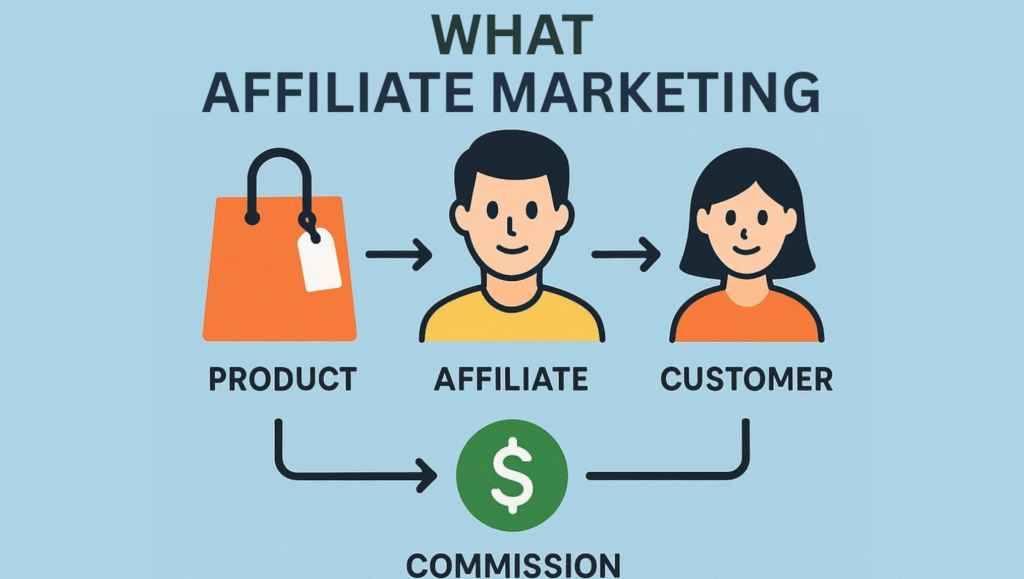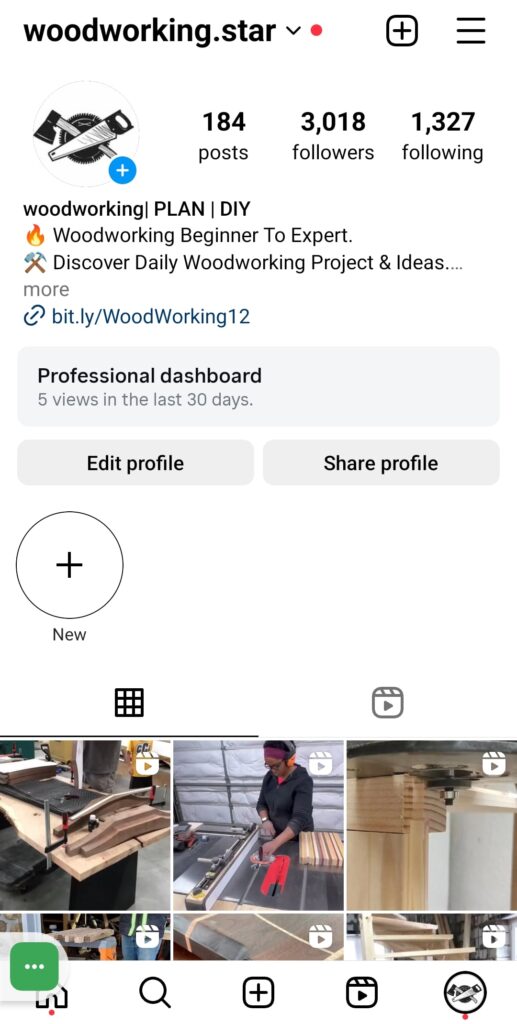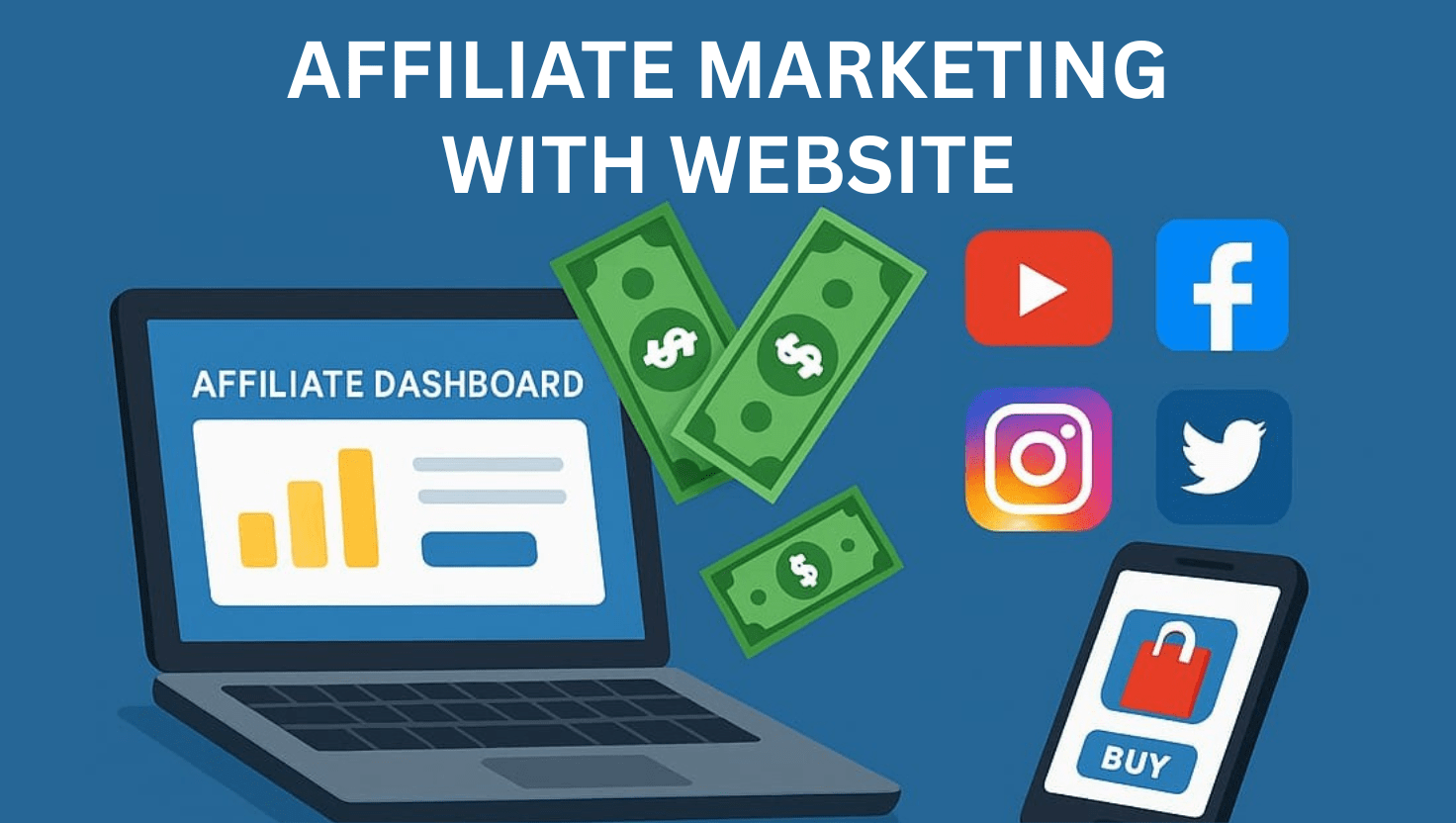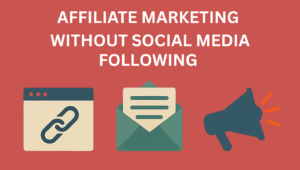You’ve probably seen those Instagram reels of people showcasing their affiliate earnings—$1,000, $5,000, and even $10,000+ per month. Pretty tempting, right? But then reality hits: you think you need a fancy website to get started, and that feels overwhelming.
Here’s the thing—you don’t need a website at all.
This guide will walk you through 5 methods of starting affiliate marketing without a website. You might reach your $1,000 affiliate commission milestone.
Whether you’re a complete beginner with zero technical skill or someone looking forward to earning their first commission.
This guide will show you how to start affiliate marketing without a website. You’ll discover 5 proven methods that successful affiliates use to earn substantial commissions, along with practical tools, legal considerations, and a step-by-step action plan to get you started within 30 days.
What is affiliate marketing?
Affiliate marketing is a way to earn commission by promoting other businesses’ products and services. You get paid a certain percentage of sales that are generated from your affiliate link.

Here’s how it works.
- Join the affiliate program. ( clickbank, amazon associates, etc.)
- Get your affiliate link.
- Promote this link on social media. (YouTube, Pinterest, TikTok, etc.)
- When someone buys from you link you get paid.
Commission structures differ significantly. You can earn flat fees of $5 to $500 per sale or commissions based on percentages that range from 3% to over 50%. Some programs provide recurring commissions for subscription products. The best part? Some offer recurring commissions, meaning you get paid every month for subscription products.
The appeal of affiliate marketing is its simplicity. You don’t have to create products, deal with customer service, or manage inventory.
Your role is to match the right products with the right people at the right time.
Why beginners love affiliate marketing:
- Low startup costs—no need to create products or build websites.
- Someone else handles customer service and shipping.
- Potential for passive income (though let’s be honest, it takes work upfront).
- You can start small and grow over time
Want to start affiliate marketing, but you’re confused about where to start? Affiliate marketing for beginners complete step-by-step guide.
Why Many Think Websites Are Required
Old-school marketers hammered this into everyone’s heads: “You MUST have a website for affiliate marketing!” This belief comes from the early 2000s when blogs ruled the internet.
Don’t get me wrong—websites have benefits. They build brand authority, give you complete control, and can rank in Google searches. But they also require:
- Technical skills (or money to hire someone)
- Ongoing maintenance and updates
- Hosting and domain costs
- Months before you see any traffic
For beginners wanting to earn their first commission quickly, these barriers can feel insurmountable.
The reality: Today’s most successful affiliates use multiple traffic sources. Social media platforms have billions of active users who are already looking for product recommendations. Email marketing still delivers incredible returns. Video platforms like YouTube and TikTok offer massive reach.
The core principle hasn’t changed—build relationships, provide value, and recommend products that genuinely help people. The platform doesn’t matter as much as you think.
Whether you’re creating Instagram stories, YouTube videos, Shorts, or email newsletters, the core principles remain the same: solve problems, build trust, and recommend products that genuinely help your audience, and that’s how you make money.
Method 1: Social Media Affiliate Marketing
With over 2 billion monthly users, Instagram is perfect for affiliate marketing. The key is creating authentic content that naturally incorporates product recommendations without sounding like a walking advertisement.
Begin by selecting a niche that aligns with your passion and expertise. If you’re confused about niche, then consider niches like fitness, beauty, tech gadgets, or home decor, and also go deeper one leave find some sub-niche. To succeed, you need to stay consistent with your content and niche.
You need to create a content calendar.r You need to create and post the below type of content.
- Educational posts that solve problems.
- Behind-the-scenes content that builds trust.
- Honest product reviews and comparisons.
You need to build trust with audiences before selling any product, and you do it by replying to comments, engaging with audiences.
This method helped me when I started my affiliate marketing.
Back in 2020, when the world was stuck indoors and uncertainty was everywhere, I decided to turn that challenge into an opportunity. While most people were binge-watching shows or scrolling endlessly, I took a leap and started an Instagram page in the woodworking niche.

With consistent posting, genuine engagement, and content that added real value, I grew that page from scratch. Over time, it not only gained a loyal audience but also started generating affiliate commissions.
2. Facebook and Facebook Groups
Many new affiliates underestimate Facebook’s potential, viewing it as outdated. However, with over 3 billion monthly active users, Facebook remains one of the most valuable platforms for affiliate marketing.
Facebook groups are particularly underrated. Join groups in your niche, but don’t immediately start promoting. Provide value first.
Answer questions, share helpful tips, and build relationships. When you do recommend products, people will trust your opinion because you’ve already helped them.
- First, you need to join a group related to your niche
- Provide value regularly
- Start connecting with members over comments.
- Answer their question through your knowledge.
This approach helps to build trust and positions you as a genuine person, not just a person who sells all the time in the group.
Consider creating your own Facebook group around your niche. It takes time to build, but having a community of engaged followers is incredibly valuable for affiliate marketing.
3. TikTok
TikTok’s algorithm is a game-changer because it prioritizes engagement over follower count. This means new creators can reach huge audiences if their content resonates.
What works on TikTok:
- Choose products that solve specific problems
- Create niche-focused content consistently
- Show the problem and solution in short videos
- Use trending sounds for better discoverability
- Include clear calls-to-action
Use tools like Linktree to house your affiliate links in your bio, since you can only have one clickable link.
4. Pinterest
In 2025, Pinterest us 570 million active monthly users.
Promote Affiliate Products on Pinterest the Smart Way! Pinterest is a strong visual search engine that works well for affiliate marketing.
To increase traffic and sales, create attractive pins with titles and descriptions filled with keywords. Link your pins straight to affiliate landing pages or blog posts.
How to promote affiliate product on Pinterest.
- Creating a Pinterest business account.
- Choose a profitable niche.
- Find an affiliate program.
- Design eye-catching pins.
- USE SEO to get traffic
- Link to the affiliate product
- Be consistent
Method 2: YouTube Without a Website
YouTube is the world’s second-largest search engine, making it incredibly powerful for affiliate marketing. You don’t need fancy equipment—most successful YouTubers started with just their smartphones.
- Creating Product Review Videos
YouTube is the second largest search engine in the world. It makes a powerful platform for affiliate marketers.
Product review videos are among the highest converting types of video in affiliate marketing.
You create detailed reviews that cover both pros and cons of the products you promote.
Your reviews build trust with your audience and lead to higher conversion rates on affiliate products over time.
- Tutorial and How-To video
Tutorial content helps to solve specific problems of your audiences or to learn how to use products. Tutorials and how-to videos help to become an authority in your niche.
You build loyal subscribers by consistently providing high-quality educational content that delivers real value. When you recommend affiliate products, customers buy from your link because viewers trust your expertise.
You can expect a 3-6 month timeline before you can see affiliate income from YouTube.
- YouTube Shorts for Quick Wins
YouTube Shorts is one of the easiest and fastest ways to get traffic to your affiliate link.
When you create a YouTube Shorts, you can massive audience with no subscribers, and it is very easy to produce these shorts.
This YouTube short is perfect for products because it hooks the person.
You create 60-second product showcase video, quick tips, or before-and-after demonstrations that highlight affiliate products.
Expect a 3-6 month timeline before seeing significant affiliate income from YouTube. Consistency is key—the algorithm rewards regular uploaders.
Method 3: Email Marketing Without a Website
Email marketing delivers the highest ROI of any digital marketing channel. Many affiliates see $2-4 return for every $1 spent on email marketing.
- Building an Email List Without a Website
Email marketing consistently yields the highest return on investment among all digital marketing channels. This makes it essential for dedicated affiliate marketers.
You don’t need a website to build a strong email list if you use landing page builders and social media strategies to generate leads.
You don’t need to create a website to collect leads. Instead, you can build a landing page. You don’t need technical skills to build. You can do it with a landing page builder like ClickFunnels, Flexifunnels, or ConvertKit.
You need to trade their email for some done-for-you ( DFY ) free lead magnet like ClickList, a free course. Which gives them an instant solution to their problem.
You generate leads from social media using Instagram Stories, TikTok videos, etc
2. Tools to use for email marketing
| Tool | Price | Best For | Key Features |
| MailerLite | Free up to 1,000 subscribers | Beginners | Drag-and-drop builder, automation |
| ConvertKit | Free up to 10,000 subscribers | Content creators | Visual automation, landing pages |
| GetResponse | $18/month for 1,000 subscribers | All-in-one solution | AI content generator, funnels |
| Systeme.io | Free plan available | Budget-conscious marketers | Complete funnel builder |
Method 4: Paid Advertising (Advanced Strategy)
Paid advertising is a potent strategy if you’re wondering how to start affiliate marketing without a website. You can market affiliate products to your target audience directly with paid advertisements.
If you’re willing to spend money in exchange for quicker results, paid advertising strategies are the best option.
Paid advertising means you need to pay platforms like Google, Facebook, and TikTok is show your ads to targeted audiences, and if someone clicks, you need to pay on that basis.
This method is the fastest affiliate marketing strategy for beginners, especially when you don’t have a website. Instead, you use a simple bridge page
Best Platforms for Affiliate Ads
| Platform | Best For | Beginner Tip |
| Facebook Ads | Detailed targeting options | Use eye-catching visuals |
| Instagram Ads | Visual products (beauty, lifestyle) | Try video or carousel formats |
| Google Ads | High intent searches | Focus on long-tail keywords |
| YouTube Ads | Product demonstrations | Create valuable video content |
| TikTok Ads | Viral-style content | Keep it fun and engaging |
Start small: Begin with $10-20 daily budgets to test what works. Track everything—cost per click, conversion rates, and return on ad spend. Aim for at least 3:1 return (make $3 for every $1 spent).
Scale successful campaigns gradually by increasing budgets 20-30% daily while monitoring performance.
Method 5: Content on Third-Party Platforms
Medium and LinkedIn
These platforms have built-in audiences and now rank well in Google searches. Share your expertise, experiences, and helpful advice. When appropriate, naturally mention relevant affiliate products.
The key is providing value first. Write about lessons you’ve learned, problems you’ve solved, or insights from your experience. When you mention products, it feels natural rather than forced.
Quora and Reddit
These platforms are goldmines for finding exactly what problems people are trying to solve. Search for questions in your niche, then provide genuinely helpful answers.
When recommending products, focus on how they solved your specific problem. Share real experiences rather than generic sales pitches. For example: “I struggled with this same issue until I tried [product]. Here’s exactly how it helped…”
Essential Tools You’ll Need
Link Management
- Bitly or Pretty Links: Shorten and track your affiliate links
- ClickMeter: Advanced tracking and analytics
- Custom domains: Build trust with branded short links
Content Creation
- Canva: Easy graphic design for social media
- DaVinci Resolve: Free video editing software
- Buffer or Later: Schedule posts across platforms
Top Affiliate Programs for Beginners
| Program | Why It’s Great |
| Amazon Associates | Easy approval, trusted brand, huge product selection |
| ShareASale | Access to many merchants, beginner-friendly |
| ClickBank | Digital products, high commissions, and fast approval |
FTC Compliance Requirements
The Federal Trade Commission requires you to disclose that this is an affiliate product in all promotional content. You can use ad, #affiliate, or #sponsored across all the platforms.
You need to check the platform-specific affiliate guidelines. Some platforms have built-in disclosure features that make compliance easier.
Avoiding legal issues requires staying current with FTC guidelines and implementing disclosure practices that go beyond minimum requirements to ensure complete transparency with your audience.
4-Week Action Plan
Week 1: Foundation
- Choose your niche based on interest and market demand
- Apply to 3-5 affiliate programs
- Pick 1-2 platforms to focus on initially
- Set up essential tools (email platform, link tracker, design software)
- Optimize your social profiles
Week 2-3: Content and Community
- Create a posting schedule (consistency beats perfection)
- Develop valuable content: tips, tutorials, behind-the-scenes
- Engage authentically—reply to comments and messages
- Join relevant communities and provide value first
- Build relationships before promoting anything
Week 4: Optimization
- Analyze what content performed best
- Identify your most engaged followers
- Optimize posting times and content formats
- Plan your expansion for month two
Conclusion
Starting affiliate marketing without a website is not only possible—it’s often more effective. Social media platforms give you immediate access to engaged audiences who are already looking for recommendations.
The real secret isn’t the platform you choose. It’s about consistently providing value and building genuine relationships with your audience. When people trust you, they’ll buy what you recommend.
Focus on the 80/20 rule: 80% valuable content, 20% promotional. This approach builds long-term success rather than quick burnout.
Your affiliate marketing journey can start today with nothing more than a smartphone and commitment to helping people. The tools and strategies are all here—now it’s up to you to take action.
Remember: everyone starts at zero. The difference between those who succeed and those who don’t isn’t talent or luck—it’s consistency and persistence. Start small, stay consistent, and adjust based on what you learn.
That’s how you build a real affiliate marketing business without a website.



